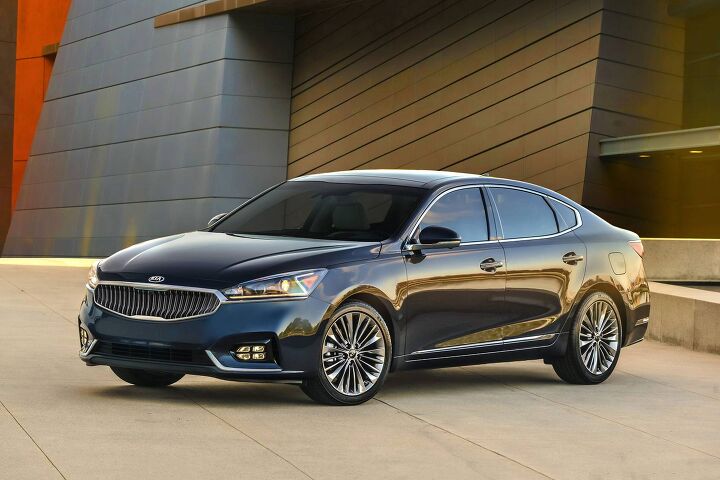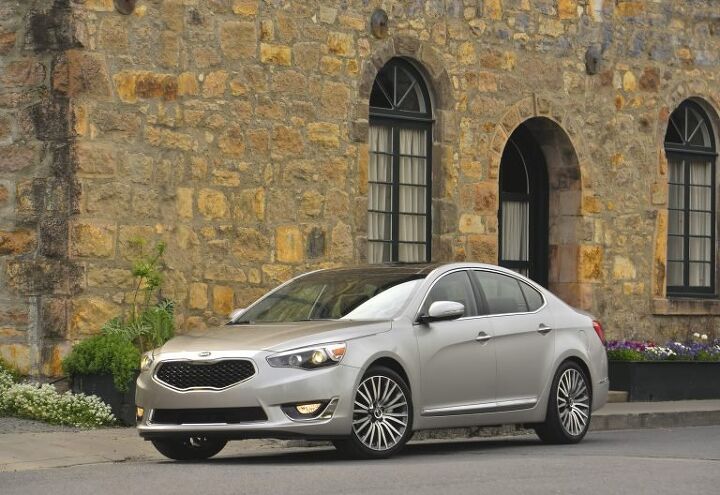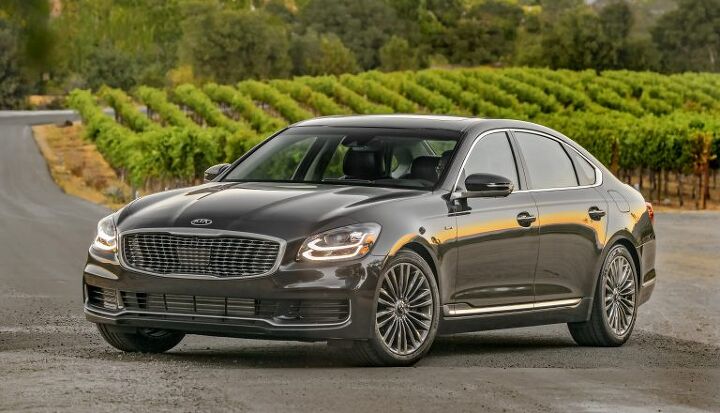#KiaCadenza
Rare Rides Icons: The History of Kia's Larger and Full-size Sedans (Part XI)
Kia’s second attempt at a K7 (Cadenza in North America) arrived at a time when the company fully embraced a styling language of its own. More upscale and nicer to look at than the derivative generation of 2010 to 2016, the new Cadenza debuted in all global markets for 2017. Kia was hopeful the second Cadenza would sell better than the first one, particularly in North America. Any predictions on how that went?
Rare Rides Icons: The History of Kia's Larger and Full-size Sedans (Part X)
As we return to the history of Kia’s large sedans, we find ourselves in the midst of the 2010s. When the full-size and rear-drive K900 was introduced for the 2015 model year, Kia’s front-drive comfort option, the K7 (Cadenza to you), was in the midst of its first generation. A replacement for the unloved and ugly Opirus (Amanti to North Americans), the K7 ushered in sophisticated but bland Euro-centric styling from Peter Schreyer upon its launch in 2010.
Cadenza didn’t make its way to the North American market until 2014, and debuted with slightly sharper styling and a nicer interior via a mid-cycle refresh. Kia took its time in bringing the Cadenza to the North American market, as they wanted to be sure they got it just right.
In the end, the first Cadenza fell between the soft rock of the Lexus ES and the hard place of the Nissan Maxima. Additionally, it lacked the prestige to compete with other large front-drive upmarket offerings of the time. The new cadenza lasted only three model years in North America, as Kia was ready for an all-new generation K7/Cadenza in 2017.
Rare Rides Icons: The History of Kia's Larger and Full-size Sedans (Part IX)
It’s time once again for more Kia large sedan goodness. Like last time, we pick up in the early 2010s. Kia’s second full-size sedan developed under Hyundai’s controllership was the K7, or Cadenza in all markets outside South Korea. Pitched as a value-priced premium front-drive car, it competed against the likes of the Toyota Avalon and Nissan Maxima, but lacked any defined comfort or sporty characteristics. Cadenza also had a bland corporate design courtesy of the company’s new Euro-like styling mission, and former VW designer Peter Schreyer.
Shortly after the Cadenza went on sale, Kia turned its sights toward an even larger sedan: A new rear-drive one to occupy the luxury space, a class above the Cadenza. It was the largest car Kia offered in nearly two decades, the first rear-drive Kia since the (Mazda Sentia) Kia Enterprise of 2002, and the first rear-drive sedan Kia ever sold in the North American market. It’s time for K9.
Rare Rides Icons: The History of Kia's Larger and Full-size Sedans (Part VIII)
We return to Kia’s large sedan history today, at a point shortly after the launch of the K7. Kia’s full-size front-drive for the 2010s, the K7 was called Cadenza in all export markets, and was a successor to the unfortunately styled Opirus (Amanti in North America). Kia hired Peter Schreyer from his longtime employment at Volkswagen Group in order to usher in a new stylistic era at Kia.
Though it went on sale for the 2010 model year, Kia wasn’t quite ready to send the Cadenza to the North American market. With the market’s general rejection of the Amanti in mind, Kia called on Schreyer to refresh the Cadenza and lux it up before its North American launch.
Rare Rides Icons: The History of Kia's Larger and Full-size Sedans (Part VII)
We return to Kia’s midsize-or-larger sedan history today in the latter portion of the 2000s. In our last entry, we learned about the Optima, which arrived as Kia’s first midsize developed under Hyundai’s majority ownership. Sensibly the Optima was a light rework of Hyundai’s Sonata, and the two shared almost everything (including very poor crash safety ratings).
On the more executive full-size side of the lineup, Kia’s Opirus was the first large car developed under Hyundai ownership. It shared a platform with the Grandeur (XG350 to you). While the Opirus saw okay sales in most markets, it failed in North America where it was sold as the Amanti. Very few North Americans wanted a $39,600 (adjusted) Kia, no matter how many luxury styling touches it borrowed from other brands. And so the Amanti was canceled after 2009 locally (2012 elsewhere). By that time its replacement was already on sale. Meet K7.
Cadenza? We Hardly Knew Ya!
Say so long to the Kia Cadenza and K900 sedans.
Cause of death: Poor sales secondary to the crossover craze and the existence of the Genesis luxury brand.
Never Gonna Give You Up: 2020 Kia Cadenza Gains Refresh, Continued Life
Is there another automotive brand that offers as much mainstream passenger car choice as Kia Motors? Nothing springs to mind. The Korean automaker continues to temp American car buyers with a full range of cars, from subcompact and compact up through full-size. In the middle, there’s a choice of THREE midsize(ish) four-doors.
In 2020.
One of those models just appeared at the Chicago Auto Show wearing slightly new clothes. It’s the Cadenza, known in some auto journo circles as the Korean Buick — a soon-to-be-outdated moniker, as the Buick lineup loses its last car this year.
Please Notice Me: Kia's Oft-overlooked Cadenza Gains a New Face for 2020
Often referred to as a “Korean Buick” (sometimes, a “ better Buick“), the Kia Cadenza sits in a corner of the vehicle theater where audience attendance is way down. The brand’s largeish midsize sedan gained a new generation for 2017, upping the model’s style and content, and it looks like Kia’s not ready to let a member of its unusually diverse passenger car lineup go ignored for too much longer.
For 2020, the sedan’s just-revealed K7 Korean twin undergoes a significant refresh, adding a touch of menace to the car’s exterior. We should see these same changes on the North American-market Cadenza in short order.
Two Large Front-drive Cars Buck the Sales Trend
April wasn’t a hot month for auto sales, what with two less selling days than the same period last year. Overall, the industry was down nearly 5 percent last month, with — in many cases — only the hottest-selling models, many of them recently revamped SUVs, posting a net gain.
April held some surprises, though, and one had to do with a pair of vehicles that should be on their way to the funeral home. That is, if all automakers acted on what they saw in the tea leaves. Certain automakers, Toyota and Kia among them, aren’t quite as eager to hop onto the all-crossovers-and-trucks bandwagon. Because of this, there’s still choice for someone looking for a large, front-wheel-drive sedan with plenty of content, but not luxury vehicle levels of it.
These people actually exist, albeit in ever smaller numbers. And these people apparently like what they see in two particular models.
Buy/Drive/Burn: The 2018 Mid-size Import Sedan Showdown
This will be our third Sedan Showdown in a row. Kicking us off were some basic full-size models, and through the “Not nice enough!” complaints, the Charger took home the win. Giving the people what they want, we turned the budget up to $45,000 and presented some luxury full-size sedans instead. Again, FCA took home a win; the Chrysler 300 easily overpowered the base Lincoln Continental, and pipped the top-trim Buick LaCrosse.
All the while, this third commenter-sourced trio waited in the wings, ready to pounce. Smaller than our previous two sets of cars, Bumpy ii wants to see you squirm and set fires. You ready? This couple is.
Light Entertainment: Answers To the Matching Taillight Challenge
Last week, we showed you four different vehicles, each with strikingly similar taillamps. So began the Taillamp Identification Challenge. (Un)fortunately, Flybrian was around, and came up with the correct answers just 10 minutes after the post went live.
So, the challenge was short lived, and all props go to Flybrian’s keen taillamp eye. It’s almost like he knows cars, or is a car dealer perhaps. Time for the official results.
Kia Cadenza Will Get a Second Chance
The Kia Cadenza, a car I think is probably the best front-wheel drive Lincoln that Ford never built, will get redesigned for 2017. What surprises me more than the Cadenza’s ability to be an effortlessly comfortable full-size sedan is that it will get a second generation at all.
Kia revealed three teaser images for their Amanti successor on Thursday. From the looks of the drawings, it likely won’t change much. That’s not such a bad thing, is it?
Review: 2014 Kia Cadenza (With Video)
Kia has big plans for America. The Korean brand that was written off in the 1990s, and is best known for making inexpensive cars with long warranties, isn’t planning an assault on the mass market. Kia has bigger plans: compete head on with Lexus, BMW and Mercedes. Say what? Yep. By 2017 Kia promises they will be ready. Rather than leaping right into the market, Kia is dipping their toes into the murky waters of the near-luxury pool. In many ways the near-luxury segment is a harder place to compete. This segment is full of aspiring brands trying to move up (Buick and Cadillac), brands that are floundering (Acura), brands that are treading water (Volvo and Lexus’s FWD models ), brands trying to expand down (Mercedes with the CLA) and brands that have no idea what their mission is (Lincoln). Into this smorgasbord lands a sedan that managed to be the most exciting car I have driven this year and the most awkwardly named. Now that I have that spoiler out of the way, let’s dive into the Credenza. I mean Cadenza.

























Recent Comments